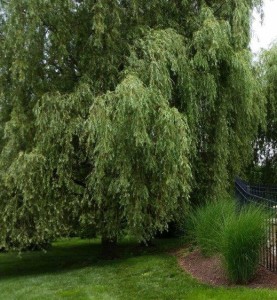Hello fellow readers,
Last week, we heard from Craig of Frelinghuysen about his Weeping Willows Gone Wild next to his pool. ‘They’re beautiful trees but cause countless hours of cleanup,” explained Craig, who went on to rant about each stage of his dirty dilemma, giving us all a good laugh. The most recent dilemma was a massive cluster of ants that took up residence under his trees. They were feeding on a gooey substance called honeydew, which was produced by the giant willow aphids that had infected his trees.
I asked Craig for an update and wondered if the weeping willow planted near the backwash had the same sticky stuff. My theory was that the tree might have been spared, as, unlike his other trees planted in dry areas, it likely receives plenty of water, though the backwash water is treated with chlorine. While willows can handle occasional drought, they thrive in water. As with all plants, providing the right cultural environment keeps them healthy and less prone to insects or disease.
“We got lots of rain over the last few days, so the trees, lawn, and pool deck have been cleansed of the sticky goo, and the ants are gone,” Craig said.
“I’m hoping the aphids have all been washed from the leaves and will take the rest of the season off. The chlorinated tree had the same amount of honeydew as the others. I’m not really sure about swarms of ants under that tree because it’s all thick grass, but I suspect they were having a party over there, too.”
A Go-to Aphid Remedy
A go-to aphid remedy is to knock them off using a strong spray of water from the garden hose in the early morning every other day for about a week. Our rainy spell likely did the job for Craig. Getting rid of the ants is also essential, as they kill beneficial insects, such as ladybugs and lacewings, that prey on aphids. You can use an organic aphid control pesticide, such as Neem Oil, which will also take care of the ants.
The grass growing under the willows is hogging moisture and nutrients from the trees. It would be best to remove the grass and install hardwood or hemlock mulch out to the drip line to help maintain the moisture. That will also reduce the need for leaf raking. The fallen leaves should remain in place to decompose and add nutrients to the soil.
There, there, Mr. Fastidious. It’s all about acceptance. And making the best environment for you AND your plants.
Garden Dilemmas? AskMaryAtone@gmail.com and your favorite Podcast App.
Link to Weeping Willows Gone Wild (Part 1)
Column updated 9/27/25



